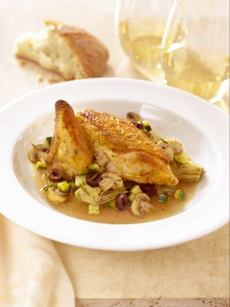
 Most of us have made a chicken and mushroom dish like Chicken Toscana, above. But using white button mushrooms is just the tip of the iceberg! Photo courtesy of MushroomInfo.com. The recipe is on the website. Most of us have made a chicken and mushroom dish like Chicken Toscana, above. But using white button mushrooms is just the tip of the iceberg! Photo courtesy of MushroomInfo.com. The recipe is on the website.
September 2009
|
 |
Cooking With Mushrooms
Page 1: Mushroom Overview
CAPSULE REPORT: Every time we see mushrooms we snatch them up, so we always have some on hand. Low calorie, fat-free, and nutritious, they’re such versatile ingredient for breakfast, lunch, dinner or snacks. Here, you’ll find out why certain recipes specifically call for one type of mushroom over another, and how you can incorporate mushrooms into your culinary repertoire without breaking the bank. This is page 1 of a five-page article. Click on the black links below to visit the other pages.
Mushroom Cooking Overview
September may be Mushroom Month, but every month is the right month to serve mushrooms. Their versatility makes them tasty both whole and uncooked, for breakfast, lunch, dinner or snacks; in appetizers, sides and main. Mushrooms infuse flavor into sauces, stocks and soups. They’re a favorite of great cooks everywhere. Plus:
- Mushrooms Are Inexpensive. White button mushrooms typically cost less than $3.00/pound and can be used in almost any recipe calling for more expensive wild mushrooms.
- Mushrooms Are Nutritious. They contribute vitamins B6, C, D, riboflavin (B2), niacin (B3), pantheonic acid (B5) and thiamin (B1); folate, iron, manganese, magnesium, phosphorus and potassium. One serving contains one-third of an adult’s Daily Value of cancer-fighting trace mineral selenium, as well as copper and thiamin. They are a very good source of dietary fiber.
- Mushrooms Are Low-Caloric. Mushrooms have virtually no fat or cholesterol and are low in calories: 44 calories a cup.
Money-Saving Tips
After you bring your fabulous fungi home from the store, get your money’s worth with these tips that stretch the life of your mushrooms:
- Keep Them Dry. While mushrooms grow in damp earth, after they’re harvested, they need to be kept from moisture. If you’ve brought them home in a plastic bag from the store, transfer them into a porous paper bag, which will help absorb some of the moisture that plastic traps in. This keeps your mushrooms dry and fresh longer.
- Plastic Box Packaging. In general, mushrooms that look fresh when you buy them will keep for up to a week in the refrigerator in their original packaging.
- Cleaning. Don’t clean your mushrooms until you’re ready to use them.
- Food-Saving Tip #1. Don’t let good mushrooms go bad. If you’ve purchased more than you need for your recipe, sauté all the mushrooms at once, and put the leftovers back in the fridge so they’ll be ready to toss into other meals throughout the week. Not only does that ensure you don’t end up with spoiled mushrooms, but it saves on cooking time, too! Or, plan to use the rest of them raw in a salad or in one of the uses in the next tip.
- Food-Saving Tip #1. Even sautéed mushrooms will only last a week; so if you don’t have a use for them, stick them in the freezer with a “use by” date. They’ll keep for up to a month. Plan to use them in an omelet, sauce, soups or stew; as a topping for pasta, rice or a protein; or as a side dish. Sautéed mushrooms with grated cheese and a bit of fresh parsley or other herb are an easy side dish. Sautéed mushrooms are also delicious on toast, with or without eggs, for breakfast or as a snack.
Continue To Page 2: How To Select Mushrooms
Go To The Article Index Above
Information courtesy of the Mushroom Council and mushroominfo.com. Other material

|


 Most of us have made a chicken and mushroom dish like Chicken Toscana, above. But using white button mushrooms is just the tip of the iceberg! Photo courtesy of MushroomInfo.com. The recipe is on the website.
Most of us have made a chicken and mushroom dish like Chicken Toscana, above. But using white button mushrooms is just the tip of the iceberg! Photo courtesy of MushroomInfo.com. The recipe is on the website.